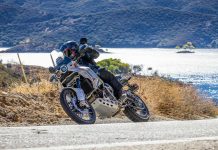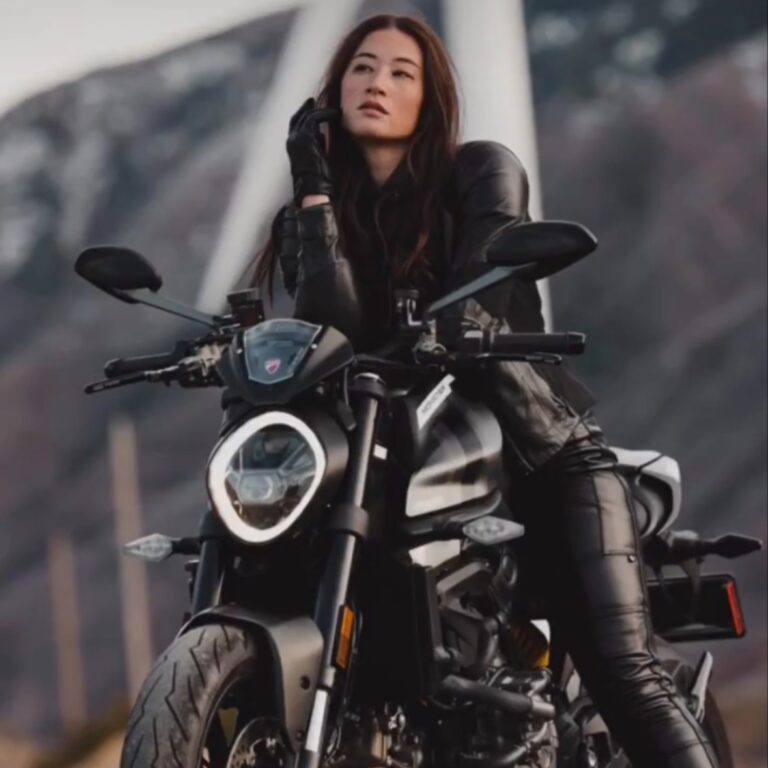Motorcycle Review
As I was riding down Nacimiento-Fergusson Road, which joins the central California’s El Camino Real (aka US 101) with the Cabrillo Highway (aka California State Route 1), I suddenly realized I had forgotten I was on a motorcycle.
Swooping down toward the rocky coastline, surrounded alternately by canopies of trees and, quite literally, breathtaking panoramic views, the Kawasaki KLR650 was transporting me so naturally that I felt like I was floating down the Los Padres National Forest hillsides on my own, rather than riding a rather prosaic dual sport bike.
 Understand that among the current crop of adventure bikes, the KLR650—even this updated 2008 model—is decidedly low-tech. But, when you are taking a motorcycle on an adventure ride, far from the protective cocoon of cell phones and AAA rescue, the simple reliability associated with a single-cylinder motor designed over 20 years ago, and still fed by a carburetor, can be an appealing proposition.
Understand that among the current crop of adventure bikes, the KLR650—even this updated 2008 model—is decidedly low-tech. But, when you are taking a motorcycle on an adventure ride, far from the protective cocoon of cell phones and AAA rescue, the simple reliability associated with a single-cylinder motor designed over 20 years ago, and still fed by a carburetor, can be an appealing proposition.
The ability of the KLR650 to do so much with seemingly so little is a testament to the importance of proper design over a reliance on technological wizardry, while at the same time acknowledging that motorcycling has benefited greatly from applications of scientific sophistication.
As part of the ’08 reworking, the motor received just a few updates—new cam timing to boost high rpm power, torque-enhancing intake porting, a smoother flowing exhaust and a digital CDI for snappier throttle response. Happily, the result is flawless, and the new version of the liquid-cooled, 4-valve, SOHC mill is all about invisibility.
The engine reacts so transparently to throttle input that you never need to put much thought into the power. There are no glitches or hits in the powerband. From idle to redline (which you only see on purpose), the perfectly adequate torque and horsepower is always there when you need it. You’re never overwhelmed or surprised—you’re simply satisfied. Dual engine balancers keep it smooth and add to the stealth nature of the motor.
A great engine is meaningless without a correspondingly superb chassis and suspension. Again, the KLR650 achieves greatness with the most basic of tools. Kawasaki replaced the saggy long-travel suspension of the previous KLR650, with shorter-travel, taut suspension (about an inch less at each end—now just above seven inches in the rear and shy of eight in the front). The Uni-Trak rear linkage was reworked and a new swingarm fitted, while the fork diameter was bumped up 3mm to 41mm.
Interestingly, the shorter suspension works better on both the street and the dirt. Excessive sag caused the old KLR to wallow in the corners on pavement and wasted the long-travel suspension that no one was going to use in the dirt anyway. The bike was never intended to pound whoops or do triple jumps, so long travel suspension was unnecessary. With this improved action, the KLR still has all the travel it needs, no matter where you are tempted to take it. On the street, handling is about as neutral as Switzerland.
On the street, handling is about as neutral as Switzerland.
The KLR is a wonderfully intuitive bike, which put me in the position I found myself at the beginning of this story—daydreaming about my surroundings, rather than concentrating on the task of riding. Sure, the fact that there were no other vehicles around on this lonely, spectacular road contributed to the sensation. However, a bike that does so much of the work for you encourages that reaction.
The braking has also been upgraded this year, and it is particularly noticeable up front, where the disc was upped 20mm to 280mm and given the petal treatment. The rear caliper was redesigned, but the difference in performance is not as stark. Hard braking also redirected attention to the front suspension, which dives far less this year under aggressive deceleration. (Click image to enlarge)
Although tight country roads—two lanes or less—are the natural habitat of the KLR650, it is still a credible freeway bike. Cruising at the speed limit, whatever that may be, can be an easily accomplished all-day affair, even though the KLR still utilizes only a five-speed transmission. Kawasaki increased fairing protection, while retaining the 6.1-gallon fuel tank, so you’ll stop when you choose to and not before. Outstanding ergonomics also contribute to the bike’s long-distance capabilities, as does the new, firmer seat. The new dual-bulb headlight is brighter, and can be seen in daylight shade.
 RIDING STYLE
RIDING STYLE
Helmet: Arai XD (DC)
Goggles: ProGrip 3400
Jacket: Shift Racing XC
Gloves: Shift Racing Chill
Pants: Shift Racing Recon Ride
Boots: Sidi Discovery. (Click image to enlarge)
 Kawasaki did make the KLR650 a better dirt motorcycle, but unpaved roads are still tricky. The bike can handle streams and bermed trails, but the tires are not up to fast, flat cornering. The front end pushes at will (its own), so flattracking is not an option. The KLR can be leaned over quite far on the street—there is no shortage of ground clearance—but that’s not an option on dirt roads. Ultimately, considering its street prowess, it is quite competent off-road, as long as you recognize its limitations.
Kawasaki did make the KLR650 a better dirt motorcycle, but unpaved roads are still tricky. The bike can handle streams and bermed trails, but the tires are not up to fast, flat cornering. The front end pushes at will (its own), so flattracking is not an option. The KLR can be leaned over quite far on the street—there is no shortage of ground clearance—but that’s not an option on dirt roads. Ultimately, considering its street prowess, it is quite competent off-road, as long as you recognize its limitations.
Nibbling at the edges may not have seemed like a winning strategy for upgrading the KLR650 for 2008, but Kawasaki used its resources wisely, turning a competent bike into a great one. (Click image to enlarge)



![2023 KTM 390 Adventure Review [15 Fast Facts] 2023 KTM 390 Adventure Review: For Sale](https://ultimatemotorcycling.com/wp-content/uploads/2023/10/2023-ktm-390-adventure-review-24-218x150.webp)
![2023 Kawasaki KLR650 S ABS Review [15 Fast Facts]](https://ultimatemotorcycling.com/wp-content/uploads/2023/10/2023-kawasaki-klr650-s-review-dual-sport-adventure-motorcycle-14-218x150.webp)
